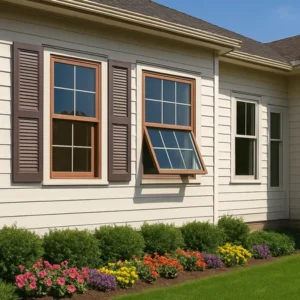At Windows on Washington, we know a thing or two about replacement roofs. The good news is if you are thinking about replacing or repairing your roof, modern roofing materials are known for their quality fabrication and durability, and are easily able to withstand even the harshest elements of mother nature. In saying that, however, not all roofing components and materials are created equal, so before you invest in a new roof, it is important you understand the different components of a roof, as well as the materials available to you. We will be covering everything you need to know about roofing components and materials in this article.
The 5 Main Components of a Roof
1. Roof covering A roof’s covering can include shingles, tile, slate or metal, as well as an underlayment that protects the sheathing from exposure and weather.
2. Sheathing The sheathing of a roof includes the boards or sheet materials that are fastened to a roof’s rafters to cover the house.
3. Roof structure A roof’s structure is made up of rafters and trusses, which are made to support the sheathing.
4. Flashing Flashing is installed into a roof system’s joints and valleys to prevent water getting in.
5. Drainage A roof’s drainage system refers to its shape, slope and layout that all impact a roof’s ability to shed water.
The Most Common Roofing Materials
Asphalt Shingles
Most homeowners opt for asphalt shingles thanks to its low cost, ease of installation and durability. Another benefit of asphalt shingles is that they are available in many different colors, while also coming in either a traditional 3-tab shingles or thicker laminated “architectural” shingles.
Asphalt shingles are comprised of either a paper fiber mat (which is ideal for homes in colder climates) or fiberglass (better for homes in fire-prone regions) infused with asphalt and coated with mineral granules.
Another of its benefits is it is one of the cheapest roofing materials on the market. A down side, however, is asphalt shingles have a lower re-sale value and a shorter lifespan than other roofing materials.
Wood Shingles and Shakes
Wood shingles and wood shakes come in a variety of woods, such as cedar, redwood and pine. The difference between wood shingles and shakes is wood shingles are machine cut, while wood shakes are hand cut, which offers a more rustic look and feel. Wood shingles and wood shakes are ideal for bungalows, as well as historic properties.
While wood is a natural product and much eco-friendlier than other roofing options, maintenance can be an issue for some homeowners. Furthermore, wood roofs often have poor fire safety ratings and can be susceptible to rotting, splitting and mold.
Metal (Steel, Aluminum, Tile, and Copper)
Metal roofs are very modern and come in a variety of styles and materials. Available in copper, aluminum, and stainless steel, metal roofs typically contain a large percentage of recycled material. Metal roofs offer high thermal/solar reflectance and are highly durable, often lasting twice as long as wood or asphalt roofs.
Furthermore, metal shingles are much lighter than other roofing materials on the market and can easily resist inclement weather. Metal shingles come in many styles and generally mirror the look of traditional roof coverings like shingles, slate and tile.
Metal roofs offer homeowners with plenty of stylistic choices, are eco-friendly and very affordable, making it a good choice for almost any home.
Clay and Concrete Tiles
Clay and concrete tiles are a popular choice amongst homeowners. Clay tiles are non-combustible and durable, but they are quite heavy and normally need additional roof framing. Clay roofing comes in lighter colors too, which helps it reflect solar energy while adhering to cool roof standards.
Concrete roofing tiles also offer a great look and feel to your home. They are versatile and come in many design options, including colors, shapes and textures. Both clay and concrete roofing tiles are naturally fire-resistant, offer a good level of insulation and have high impact and wind lift resistance. The main disadvantage to clay and concrete tiles are weight and cost.
{{cta(‘8c8ebe87-3dbb-47b1-b0ea-08ea42cf678a’)}}



